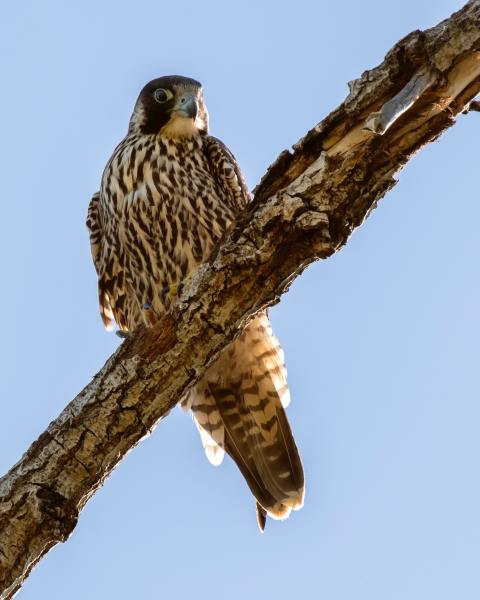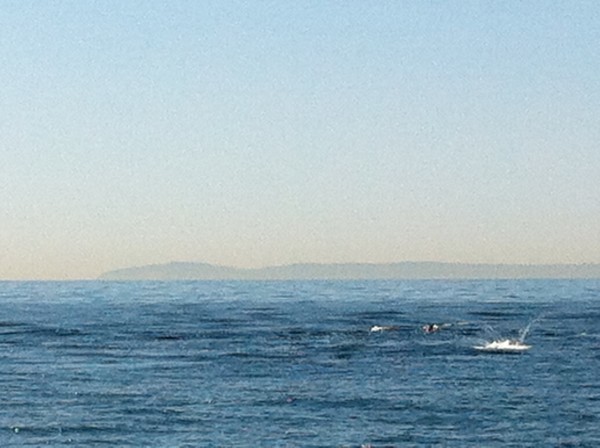On a recent trail assessment in Laguna Coast Wilderness Park, I spent a moment taking in the beautiful views around me and thought to myself, this seems like the perfect habitat for a Peregrine Falcon. With its high cliffs and sprawling vegetation, the area seemed like an ideal place for a falcon to perch and rapidly descend on unsuspecting prey. Not much later, I heard the familiar high-pitched call and saw a Peregrine Falcon perched within a cavity in the rock face.
A wildlife sighting like that is life-affirming. The Peregrines are an “indicator species,” and tell a broader story of a healthy eco-system. Their presence also weaves into a larger narrative of conservation and the continual work we all have to do to protect wildlife and our wild places.
 Until it was outlawed in the 1970s, widespread use of DDT almost wiped out the Peregrine Falcons. Working its way up through the food chain, DDT caused the birds to produce eggs whose shells were too thin and therefore less successful in hatching. They were once on the US Endangered Species List, and through conservation efforts have bounced back significantly. However, populations in the eastern US have never returned. We are fortunate that they remain abundant on the Pacific Coast today where they commonly feed on the shore birds in the area.
Until it was outlawed in the 1970s, widespread use of DDT almost wiped out the Peregrine Falcons. Working its way up through the food chain, DDT caused the birds to produce eggs whose shells were too thin and therefore less successful in hatching. They were once on the US Endangered Species List, and through conservation efforts have bounced back significantly. However, populations in the eastern US have never returned. We are fortunate that they remain abundant on the Pacific Coast today where they commonly feed on the shore birds in the area.
Peregrine Falcons are remarkable in every way. Reaching speeds of over 200 mph, they are the fastest animal on our planet. They have adapted to the urban environment, perching on skyscrapers and hunting pigeons. I fondly think back to the falcons I observed when I was a Park Ranger in Austin, Texas. If I spotted a single pigeon wing on the ground and heard the Peregrine Falcon’s distinct shriek in the wind, I could often look up and see one perched on a high-rise. It’s difficult to be unimpressed by their presence; their very existence tells the story of persistence, adaptation, and conservation.
 Like most stories in nature, the Peregrine Falcon’s is an ongoing tale of fighting against the odds. We are still dealing with the untold environmental consequences of DDT. Just last month the LA Times reported on the dumping of half a million gallons of DDT off the coast of Catalina Island between 1947 and 1961. It is unknown what the long-term consequences are, although it is clear that the bird population has declined in the surrounding Channel Islands. It is not difficult to imagine contaminated fish working their way up the food chain to affect predators like the California Condor and Peregrine Falcon. If this troubles you as it does me, remember, each of us can play an important role in protecting the wildlife in our own communities. While we cannot go scuba diving to remove the toxic waste off Catalina, we can refrain from using rodenticides that all too often kill mountain lions and birds of prey alike when they feed on poisoned rodents.
Like most stories in nature, the Peregrine Falcon’s is an ongoing tale of fighting against the odds. We are still dealing with the untold environmental consequences of DDT. Just last month the LA Times reported on the dumping of half a million gallons of DDT off the coast of Catalina Island between 1947 and 1961. It is unknown what the long-term consequences are, although it is clear that the bird population has declined in the surrounding Channel Islands. It is not difficult to imagine contaminated fish working their way up the food chain to affect predators like the California Condor and Peregrine Falcon. If this troubles you as it does me, remember, each of us can play an important role in protecting the wildlife in our own communities. While we cannot go scuba diving to remove the toxic waste off Catalina, we can refrain from using rodenticides that all too often kill mountain lions and birds of prey alike when they feed on poisoned rodents.
When we are fortunate to live close to these wild places, it is up to us to be good neighbors and stewards for the native flora and fauna. That way we will continue to see these extraordinary falcons calling these canyons their home, a life-affirming experience.
Peregrine Falcon flying by Alyssa Moreno
Peregrine Falcon on a branch photo by Frank Cone
